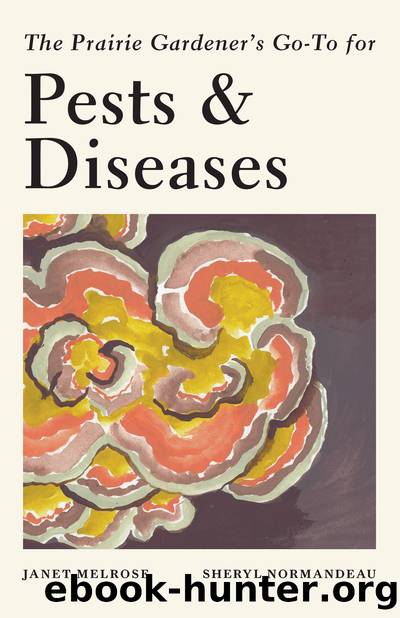The Prairie Gardener's Go-To for Pests and Diseases by Janet Melrose

Author:Janet Melrose
Language: eng
Format: epub
ISBN: 9781771513159
Publisher: Touchwood Editions
Black knot: My tree has a lumpy black growth on its branches! What is it? How do I treat it?
If your tree or shrub is of the Prunus genus that includes cherry, plum, chokecherry, Amur maple, or mayday species, chances are that the plant has been infected by the fungus Apiosporina morbosa, commonly known as black knot. While all species in the genus are susceptible to the fungus, mayday, Schubert chokecherry, and native chokecherries are the ones where the fungus is the most aggressive and have been the hardest hit in recent years, with some calling the situation an epidemic. Unfortunately, in Alberta, our love of both the mayday and Schubert chokecherries, combined with some cool and wet springs a few years ago, were perfect conditions for the fungus to become endemic. It is hard these days to walk down an urban street and not see just about every tree affected to some degree, or stroll in a wild area and not see all our native chokecherry shrubs bearing the telltale black knobby growths on their branches, stems, or trunks.
There is no cure or treatment for plants that have become infected. You can only mitigate the situation by pruning, so knowledge of how the fungus works and good cultural techniques are key to keeping your plants healthy.
The fungus spreads by way of ascospores that grow on the surface of the cankers and are released in the spring after a mild period of rainy and windy weather. If the plant is of a species that is a host to the fungus, a small olive-green gall will develop at the site of infection. The gall will slowly grow over several years and turn black. As the galls increase in size, they girdle the tree branches and trunk.
To try to prolong the lives of diseased trees, prune out all knots on the branches during the late fall, winter, or early spring. Cut at least six to eight inches (fifteen to twenty centimetres) below the knots. Do not leave branch stubs. The infected plant parts must not be composted. Look to your municipalityâs regulations regarding disposal in your area.
Minimize the stress on your Prunus trees by sticking to a consistent watering schedule throughout the growing season. A side dressing of compost once per year, in the spring, may be useful.1âJM
If your tree belongs to the genus Prunus and it is sporting growths like this, youâll need to get out the pruning tools.
Download
This site does not store any files on its server. We only index and link to content provided by other sites. Please contact the content providers to delete copyright contents if any and email us, we'll remove relevant links or contents immediately.
The Secret History by Donna Tartt(18849)
Goodbye, Things by Fumio Sasaki(8478)
Wonder by R. J. Palacio(8010)
Turbulence by E. J. Noyes(7936)
How to Be a Bawse: A Guide to Conquering Life by Lilly Singh(7393)
Kaplan MCAT General Chemistry Review by Kaplan(6867)
The Thirst by Nesbo Jo(6828)
The Testaments by Margaret Atwood(6774)
The Last Wish (The Witcher Book 1) by Andrzej Sapkowski(5391)
Spare by Prince Harry The Duke of Sussex(5072)
The Body: A Guide for Occupants by Bill Bryson(4974)
On Writing A Memoir of the Craft by Stephen King(4863)
The Rules Do Not Apply by Ariel Levy(4861)
Audition by Ryu Murakami(4850)
The Doodle Revolution by Sunni Brown(4687)
Gerald's Game by Stephen King(4583)
Adulting by Kelly Williams Brown(4487)
Millionaire: The Philanderer, Gambler, and Duelist Who Invented Modern Finance by Janet Gleeson(4376)
Housekeeping by Marilynne Robinson(4347)
